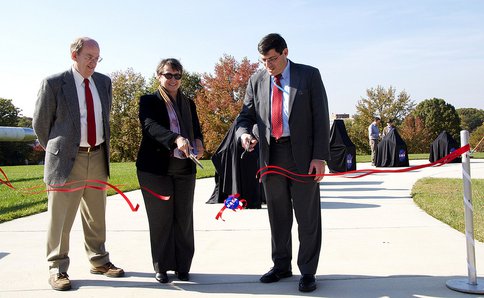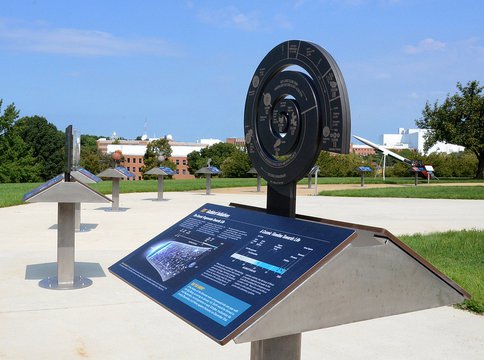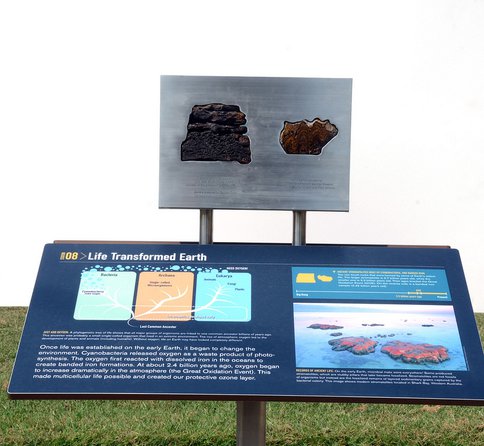2013 Annual Science Report
 NASA Goddard Space Flight Center
Reporting | SEP 2012 – AUG 2013
NASA Goddard Space Flight Center
Reporting | SEP 2012 – AUG 2013
The Astrobiology Walk
Project Summary
The Goddard Center for Astrobiology (GCA) has completed the development and installation of a permanent outdoor exhibit at the Goddard Space Flight Center (GSFC) Visitor Center as a major public outreach effort. The “Astrobiology Walk” is designed to showcase the latest scientific discoveries from the GCA research theme “Search for the Origin and Evolution of Organics” in the context of a timeline for the evolution of the Universe and the Solar System. The exhibit consists of ten outdoor stations situated on the circular pathway around the Visi-tor Center’s “Rocket Garden”, each with a memorable iconic 3D object to convey the main scientific message. QR codes link each placard to web sites relevant to that topic.
Project Progress
In September 2012, GCA completed a 12-month internal conceptual design study of the Astrobiology Walk, and initiated a competitive procurement process for its final (museum quality) physical design and installation. In September 2012, GCA selected and awarded the contract to C&G Partners (C&G) and Exhibitology to perform the physical design, fabrication and installation of the exhibit (C&G was the exhibitor that developed the famous “Planet Walk” in downtown Washington, DC). The Astrobiology Walk exhibit was completed in August 2013 and was formally commissioned on October 29, 2013.
The Walk consists of ten outdoor interpretive stations situated on the circular pathway around the Visitor Center’s rocket garden, each with two placards and a memorable iconic 3D object to convey the main scientific message.
The topics include the origin of biocentric elements, inorganic and organic molecules, the formation and dynamic evolution of the solar system, the role of comets and meteorites in the delivery of prebiotic molecules and water to the early Earth, exoplanets, and the search for biomarkers on Mars.
Many GCA scientists, GSFC EPO personnel, science writers and graphics designers participated in an intensive effort to further design and develop the station placards in partnership with C&G October 2012 through February 2013. It was a challenge to create scientific content that was targeted for middle school students, yet would likely not be outdated within the next five to ten years for the fast-moving field of Astrobiology. The design solutions included identifying appropriate initial content, making placards replaceable, and providing for station additions. A GCA scientist with expertise in the particular sub-discipline was responsible for designing the relevant station. Each station is standalone, but is also a part of a time sequence to tell the story of the cosmic progression towards life from the Big Bang to the present habitable Earth. The station placards contain many original graphics and are very rich in content. GCA was able to obtain permission from artists and photographers to use images that are copyrighted. Each placard also has a Quick Response (QR) code sticker to enable visitors with smart mobile devices to link immediately to more in-depth scientific resources on the Astrobiology Walk webpages (http://astrobiowalk.gsfc.nasa.gov).
A memorable 3D iconic object is mounted on top of each interpretive station to highlight the main scientific message. The 3D icons are weatherproof and permit tactile interaction with younger audience and sight-challenged visitors. Stromatolites that bracket the Great Oxidation Event (2.7-2.4 Ga) and a sample of banded iron from that oxygen-forming epoch are mounted on the station “Life Transformed Earth”.
Several icons are created using data acquired by NASA planetary missions to give an accurate representation of the Solar System objects. For example, the GSFC Mars Orbiter Laser Altimetry (MOLA) team generated topographic data to produce a Mars globe with surface relief that is exaggerated tenfold to highlight features such as volcanoes and canyons for the station “Search for Life on Mars”.
GCA colleagues from the University of Maryland EPOXI team generated a 3D shape model of the comet 103P/Hartley-2 nucleus for the station “Messengers from the Early Solar System”.
The fabrication and installation of the Astrobiology Walk was completed in August 2013. The ribbon cutting ceremony was delayed until October 29, 2013, due to the government shutdown. The exhibit revitalizes the Goddard Visitor Center’s Rocket Garden and is a major attraction to school groups, scout troupes and other visitors. Visitors have spent up to an hour viewing the outdoor exhibit under the hot summer sun. A bookmark and a trifold brochure that serves as a self-guided tour of the exhibit were developed with the support of NAI EPO Supplemental funds. An Educator’s Resource guide is currently in development to provide more in-depth treatment of the scientific topics for visiting school groups.
-
PROJECT INVESTIGATORS:
-
PROJECT MEMBERS:
Erwan Mazarico
Project Investigator
Brooke Norsted
Project Investigator
Peter Thomas
Project Investigator
Malcolm Walter
Project Investigator
Michael A'Hearn
Collaborator
Michael Callahan
Collaborator
George Cody
Collaborator
Jamie Cook
Collaborator
Michael DiSanti
Collaborator
Jason Dworkin
Collaborator
Corinne Eby
Collaborator
Jennifer Eigenbrode
Collaborator
Tony Farnham
Collaborator
David Flannery
Collaborator
Jay Friedlander
Collaborator
Perry Gerakines
Collaborator
Daniel Glavin
Collaborator
Theodore Griswold
Collaborator
Reggie Hudson
Collaborator
Clark Johnson
Collaborator
Natasha Johnson
Collaborator
Harold Levison
Collaborator
Avi Mandell
Collaborator
Marla Moore
Collaborator
Gregory Newmann
Collaborator
Joseph Nuth
Collaborator
Aki Roberge
Collaborator
Geronimo Villanueva
Collaborator
Elizabeth Zubritsky
Collaborator
-
RELATED OBJECTIVES:
Objective 1.1
Formation and evolution of habitable planets.
Objective 1.2
Indirect and direct astronomical observations of extrasolar habitable planets.
Objective 2.1
Mars exploration.
Objective 2.2
Outer Solar System exploration
Objective 3.1
Sources of prebiotic materials and catalysts
Objective 3.2
Origins and evolution of functional biomolecules
Objective 4.1
Earth's early biosphere.
Objective 4.3
Effects of extraterrestrial events upon the biosphere
Objective 7.1
Biosignatures to be sought in Solar System materials
Objective 7.2
Biosignatures to be sought in nearby planetary systems





